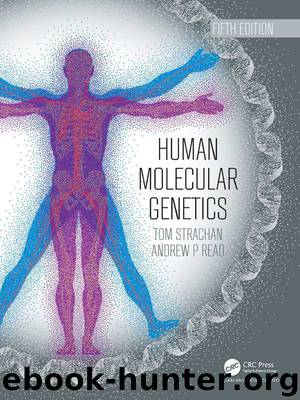Human Molecular Genetics by Strachan Tom & Read Andrew

Author:Strachan, Tom & Read, Andrew [Strachan, Tom]
Language: eng
Format: epub
ISBN: 9780429827464
Publisher: CRC Press
Published: 2018-12-19T16:00:00+00:00
Unaffected
Affected
Genotype
AA
Aa
aa
H–W frequency
p 2
2 pq
q 2 = 1/2000
q 2 = 1/2000, therefore q = √(1/2000) × 1/45. p = 1 − q = 44/45, so 2 pq = 2 × 44/45 × 1/45 = 1/23.
The fiancé has a 1 in 23 chance of being a carrier. For the woman, her risk follows from simple Mendelian segregation ( Figure 12.1 ).
Figure 12.1 Carrier risk for the unaffected sister of a person with cystic fibrosis. She has an affected brother, so both her parents must be carriers (there is a negligible rate of fresh mutation for cystic fibrosis). The genotype probabilities for their children are as shown. The chance the unaffected sister is a carrier is not 1 in 2; it is 2 in 3 because we know she has one of the genotypes in the shaded box.
The chance that both partners are carriers is 1/23 × 2/3, and the risk that any child of theirs would be affected is 1/23 × 2/3 × 1/4 = 1 in 138. Should they risk having children? That is their own personal decision. The job of the genetic counselor is to explain the risk, to make sure they fully understand it, to help them arrive at their own decision, and to support them in that decision, whatever it is. The counselor might point out that any pregnancy is at 1–2% risk of producing an abnormal baby, so the extra risk due to cystic fibrosis should be seen in that context, but it is not for the counselor to tell them what to do.
For X-linked loci (see Figure 5.5 ), males, being hemizygous (having only one allele), are A or a with frequencies p and q , respectively, whereas females can be AA , Aa , or aa ( Figure 12.2 ). So, for example, if a survey shows that one man in 12 has X-linked red–green color blindness, we can see directly that q = 1/12, and so we would predict that one woman in 144 would be affected, and 22 in 144 would be carriers. In reality the genetics of red–green color blindness is rather more complicated, but hopefully this simplified example serves present purposes.
Download
This site does not store any files on its server. We only index and link to content provided by other sites. Please contact the content providers to delete copyright contents if any and email us, we'll remove relevant links or contents immediately.
| Cell Biology | Developmental Biology |
| Entomology | Marine Biology |
| Microbiology | Molecular Biology |
| Biostatistics |
Sapiens: A Brief History of Humankind by Yuval Noah Harari(13072)
The Tidewater Tales by John Barth(12038)
Do No Harm Stories of Life, Death and Brain Surgery by Henry Marsh(6342)
Mastermind: How to Think Like Sherlock Holmes by Maria Konnikova(6250)
The Thirst by Nesbo Jo(5791)
Why We Sleep: Unlocking the Power of Sleep and Dreams by Matthew Walker(5655)
Sapiens by Yuval Noah Harari(4551)
Life 3.0: Being Human in the Age of Artificial Intelligence by Tegmark Max(4519)
The Longevity Diet by Valter Longo(4451)
The Rules Do Not Apply by Ariel Levy(3913)
The Immortal Life of Henrietta Lacks by Rebecca Skloot(3832)
The Body: A Guide for Occupants by Bill Bryson(3813)
Why We Sleep by Matthew Walker(3779)
Animal Frequency by Melissa Alvarez(3759)
Yoga Anatomy by Kaminoff Leslie(3709)
Barron's AP Biology by Goldberg M.S. Deborah T(3636)
The Hacking of the American Mind by Robert H. Lustig(3586)
All Creatures Great and Small by James Herriot(3525)
Yoga Anatomy by Leslie Kaminoff & Amy Matthews(3402)
